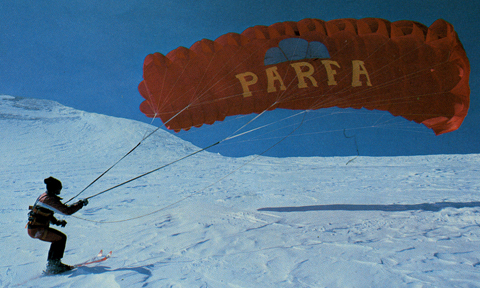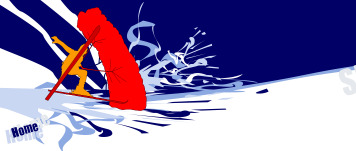FIRST FLIGHT INSTRUCTIONS
Excerpts from the Uphillracer and Skywing sailing and flying instructions
(1976-1985)
"THIS IS PARASKIING"
As far as I know, those are the first instructions to kiting and paragliding, not only in the Germanspeaking world
Translated from Italian
THE FLIGHT
Before you go flying we advise you to do an exercise with the help of an instructor or a friend. Let's attach a 10-15m long tether to the harness and put ourselves in the hands of our friend. The wind is trying to lift us up, but the traction of our friend keeps us close to the ground. We have been lifted up, so we have a first perception of flying. We can also check out the way the Paraski reacts by pulling the steering tethers. The longer the tether, the higher we ascend. Let's always stay careful and keep in mind never to attach the tether to a fixed supporting point. Align paraski well before launching on the slope, chamber openings pointing upwards, all tethers visible on canopy, stabilizer tethers not remaining under canopy. If the latter happens we have a difficult launch: the lateral section of the canopy may fall off and we may not be aple to spread the canopy. In order to avoid this it is better do everything calmly. Align canopy and tethers well in order to have a trouble-free launch. We have to carefully pick the terrain where we spread our paraski: if the slope is too steep the canopy will slip and thus prevent a good launch; we also have to avoid flat terrain with obstacles; ideal terrain would be a terrace followed by a steep slope.
That way we will have the calotte in the right place and therefore a good launch. We also have to pay close attention to the wind direction. A medium strength wind coming up from the valley and blowing straight into the paraski will help us has have a good launch. Wind blowing sideways, straight down or no wind at all means we permanently have to adjust the position of the calotte. We also have to make sure to increase our speed before taking off.
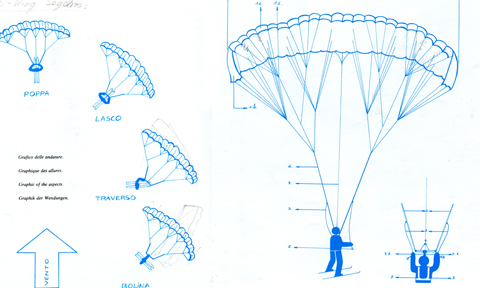
THE LAUNCH
Before the flight it is mandatory to fix the security mechanism on the skis in a way they cannot come loose during the flight. There are two different ways of having a good launch:
1) We place our skis head-on to the valley and glide down. In this moment the paraski takes off from the ground and we wait until the calotte is floating above us (horizontal position towards the ground, vertical position towards us). We then pull both steering tethers and slowly take off the ground to face our first flight. To keep the calotte in the desired position, we need to "play" with the steering tethers: Pull a bit to the left when the calotte is tilting to the right and vice versa. We also have to make sure to adjust our speed so that the calotte is right above us in a vertical position since it had been floating behind us during the launch. All this is difficult for a beginner who has to make frequent adjustments to the position of the calotte in order to keep her in balance. We must not forget that the paraski is in our rear and we therefore cannot see how it reacts.
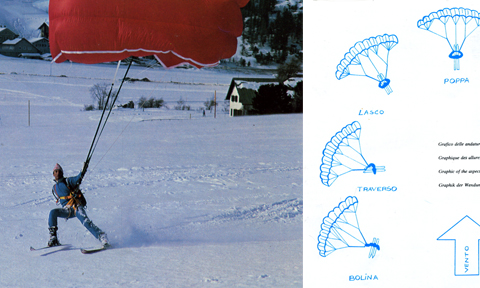
2) The second method does away with all those problems but can only be performed by skiing experts. We and our skis face the slope, i.e. the valley is in our rear. We glide down backwards and can easily watch the momevent of the calotte. We can easily adjust the calotte. When the calotte is floating in the right spot, we let go of both steering tethers and do a one-eighty with our skis. We immediately take control of the steering tethers again and pull them until we soar off the ground. This method may seem difficult to you, but after some training you will realise it is the best way to launch. At first, there is a feeling of volatility: Don't be afraid! Already after a couple of moments the canopy will stabilize and we control the flight. Our airspeed is ideal and we quickly recognize the landing site.
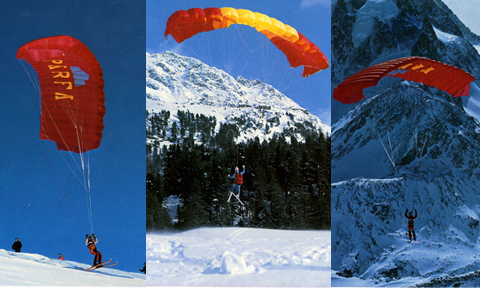
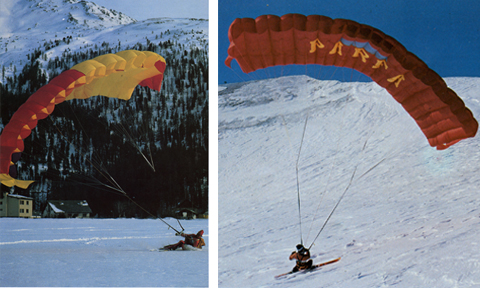
TOUCHDOWN
During the flight the paraski loses 1m in height every 4m. That way we can thouroughly plan where to land. A couple of meters before the landing we pull both steering tethers to decrease the speed of descent and make a gentle touchdown.
